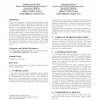Free Online Productivity Tools
i2Speak
i2Symbol
i2OCR
iTex2Img
iWeb2Print
iWeb2Shot
i2Type
iPdf2Split
iPdf2Merge
i2Bopomofo
i2Arabic
i2Style
i2Image
i2PDF
iLatex2Rtf
Sci2ools
GECCO
2005
Springer
2005
Springer
Factors governing the behavior of multiple cooperating swarms
This paper investigates the idea of having multiple swarms working separately and cooperating with each other to solve an optimization problem. Many factors that influence the behavior of this approach haven’t been properly studied. This paper investigates two factors that affect this approach behavior. These factors are: (i) the communication strategy adopted if the number of swarms is raised above two, and (ii) the number of cooperating swarms. Experiments run on different benchmark optimization functions show that adopting a circular communication strategy gives better results than just sharing the global best of all the swarms. Increasing the number of cooperating swarms provides better results provided that the appropriate synchronization period is selected. Categories and Subject Descriptors I.2 [Computing Methodologies]: Artificial Intelligence;
| Added | 27 Jun 2010 |
| Updated | 27 Jun 2010 |
| Type | Conference |
| Year | 2005 |
| Where | GECCO |
| Authors | Mohammed El-Abd, Mohamed Kamel |
Comments (0)

